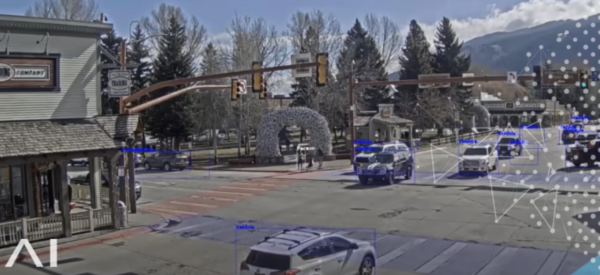
By Jay Jason Bartlett
The safe and effective movement of people and products on roads, highways, and other transportation networks depends in large part on effective traffic management. Video surveillance has developed into a crucial tool for managing traffic, enabling officials to monitor traffic flow, spot traffic infractions, and promptly address situations. The significance of video surveillance in traffic management and its advantages for drivers and traffic authorities will be discussed in this article.
Increased Flow Traffic:
To monitor traffic movement, video surveillance cameras are placed in key points on roads and highways. Traffic officials can identify crowded locations and change traffic signals to optimize traffic flow using real-time data from the cameras.
In order to avoid congestion, shorten travel times, and ensure the safe and orderly circulation of vehicles, they can also monitor traffic during peak hours and make the appropriate adjustments.
Accidents and other events that can result in traffic congestion can also be found using video surveillance cameras. The data can be used by traffic authorities to swiftly dispatch emergency services and evacuate the area, reducing the impact on traffic flow.
Lower Traffic Offenses:
Traffic accidents and congestion can result from infractions including speeding, running red lights, and unlawful parking. These infractions can be found by video surveillance cameras, which can also give evidence to punish offenders. Drivers are less inclined to break traffic laws when they are aware that they are being watched, which results in safer roads and fewer accidents.
Other traffic infractions like overloading, driving while intoxicated, and using a cellphone while driving can all be found and prevented with the aid of video surveillance cameras.
The data can be used by traffic enforcement agencies to teach motorists safe driving techniques.
Improved Security:
On roads and highways, video surveillance cameras can improve the safety of drivers and pedestrians. Cameras can pick up on shady behavior, including car theft, vandalism, and other crimes. The data can be used by traffic authorities to send out security guards and rapidly handle emergencies. Additionally, they can utilize the video as evidence in criminal prosecutions and to discourage criminal activity.
Finding lost or missing people can also be aided by video surveillance cameras. The cameras can record video of an accident or other disaster, assisting rescue workers and emergency services in promptly locating victims.
Speedier Response:
Traffic authorities may respond to situations more rapidly by using video surveillance cameras, which also minimizes the impact on traffic flow. As a result of cameras’ ability to identify incidents like accidents, breakdowns, and other occurrences, emergency services can be sent out right away. They can also keep an eye on the state of the roads during severe weather events like heavy rain, snow, or fog and take the appropriate precautions to protect drivers.
Cost-Saving Approach:
Compared to more conventional approaches like employing employees and building physical infrastructure, video surveillance is a more affordable solution for traffic management. Traffic authorities can monitor traffic around-the-clock using video surveillance cameras, which can also give them access to real-time data that helps them act quickly and rationally. In addition, they can cover a wider area and have better visibility than human staff, safeguarding the security of drivers and pedestrians.
Governments and law enforcement organizations all over the world are using video surveillance more and more to regulate traffic. The use of technology makes it possible to keep an eye on how traffic is moving, spot accidents or other events, and deal with them. However, there are certain legal issues with the use of video monitoring in traffic management.
“Video Management Systems (VMS) are a swiftly growing market due to the rapid deployment of cameras, which leverage technology to enhance safety and security in public areas. As in many other industries, Artificial Intelligence (AI) has the potential to bring VMS to the next level. When powered by AI at the edge, Video Management Systems can process an enormous amount of visual data swiftly and with minimal latency to enable real-time and accurate video analytics,” stated Orr Danon, CEO of Hailo, a developer of AI Technologies.
“Using AI for video management allows more data to be analyzed and more insights to be generated, at a lower cost of ownership and greater accuracy compared to monitoring by people. AI analysis at the edge also increases privacy, as no personal data needs to be streamed to the cloud. Many software providers already offer AI-powered applications to identify emergencies and accidents, manage and control traffic and congestion, recognize vehicle make, model and license plates, and many other use cases which help make our world a better, safer place.”
The problem of privacy is one of the biggest legal challenges.
Images and recordings of people, including their movements, behaviors, and even private information like license plate numbers, can be obtained through video surveillance. This raises questions with the right to privacy, which is safeguarded by a number of international laws and constitutions. Governments must strike a compromise between the necessity for efficient traffic management and the requirement to safeguard people’s privacy.
Data retention is a legal problem that also has to be addressed.
Usually, video surveillance footage is only kept for a short while before being erased. However, the duration of retention varies significantly between jurisdictions, and there are frequently disagreements regarding the proper amount of retention. Who has access to the material and how it is used are other issues.
To prevent data from being exploited, some contend that the use of video surveillance for traffic control ought to be rigorously constrained.
Another legal issue is that a defendant is permitted to physically confront their accusers in a court of law. According to the Sixth Amendment, a suspect in a criminal case has the right to confront a witness against him or her.
This includes the right to attend the trial in person (which is guaranteed by the Federal Rules of Criminal Procedure Rule 43). Including the ability to question the witnesses for the prosecution in person. This is the reason a traffic violation case will be dropped if the police officer who is accusing you does not appear in court.
A video surveillance camera cannot actually “appear in court” or undergo cross-examination. Many “Red Light Cameras in the U.S.” have been disabled based on this theory.
The use of video surveillance as evidence in court is likewise fraught with legal issues. The use of surveillance video as evidence in criminal or traffic trials is common in many jurisdictions.
However, there are frequently disagreements regarding the veracity of the footage, how it was collected, and if it infringes on people’s right to privacy. Due to these issues, there have been instances where video surveillance material was removed from court proceedings.
The use of video monitoring for traffic control across international borders is also subject to legal challenges. Regarding the use of video surveillance, different countries have varied laws and rules, and there are worries about how data is shared and used between nations.
Debatable topics include how to respect people’s rights to privacy when using video surveillance for cross-border traffic control.
Traffic infractions and accident costs can be decreased using videosurveillance. When traffic infractions are discovered, offenders may be punished, lessening the tax burden. The price of medical care, auto repairs, and other accident-related costs are decreased when accidents are avoided.
Governments and law enforcement organizations must strike a balance between the necessity for efficient traffic management and the requirement to respect people’s right to privacy. They
must also take into account the legal ramifications of data retention, the cross-border usage of video surveillance for traffic management, and the use of video surveillance as evidence in court.
Traffic infractions and accident costs can be decreased using video surveillance. When traffic infractions are discovered, offenders may be punished, lessening the tax burden. The price of medical care, auto repairs, and other accident-related costs are decreased when accidents are avoided.
Video surveillance is a crucial instrument in traffic management, aiding in the monitoring of traffic flow, the detection of traffic offences, the enhancement of security, the reduction of response times, and the reduction of expenses.
Compared to conventional ways, it is a more affordable alternative that covers a bigger area and offers better visibility. Traffic authorities can use video surveillance to ensure the efficient and safe movement of people and commodities on roads and highways, improving travel for both drivers and pedestrians.

Jay Jason Bartlett is the Managing Editor of Security.World and the CEO of Cozaint Corporation, a manufacturer of security surveillance solutions. Jay has over 40 years in the high-tech industry and over 15 years in physical security. visit: cozaint.com
See more articles on: Hailo
Source: Security.World
Source: cozaint.com
